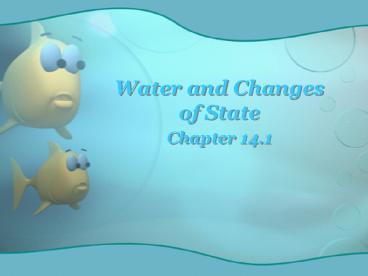Water and Changes of State - PowerPoint PPT Presentation
1 / 14
Title:
Water and Changes of State
Description:
Approximately 97% of the earth's water is found in oceans. Uses of water: ... Colorless and Tasteless. At 1 atm: Forms a solid at O. C Forms a gas at IOO ... – PowerPoint PPT presentation
Number of Views:572
Avg rating:3.0/5.0
Title: Water and Changes of State
1
Water and Changes of State
- Chapter 14.1
2
Water
- Water is the most common liquid.
- Approximately 97 of the earths water is found
in oceans. - Uses of water
- Sustains reactions within our bodies.
- Cools auto engines and nuclear power plants.
- Helps in the growth of many creatures.
3
Pure Water
- Colorless and Tasteless
- At 1 atm
- Forms a solid at O?C
- Forms a gas at IOO?C
- The liquid range of water is O?C to IOO?C
4
Figure 14.7 The heating/cooling curve for water
heated or cooled at a constant rate.
5
What does the heating/cooling curve show?
- The motions of the water molecules increase as it
is heated. - When the temperature reaches IOO?C, bubbles
develop and float to the surface. - When liquid water is cooled, the liquid begins to
freeze. - During boiling and freezing, temperature stays
constant.
6
Water is Unique
- When water freezes, it expands.
- Accounts for bursting of pipes and engine blocks
that are left unprotected in freezing weather. - The expansion of water is why ice cubes float.
(Also why ice floats on the surface of lakes
allowing life under water during winter.) - Density of water 1.00g/mL
- Density of ice 0.917 g/mL
7
Energy Requirements for Changes in State
8
Physical Changes
- A change from solid to liquid or liquid to gas
are physical changes. - No chemical bonds are broken when going from ice
to water to steam.
9
It takes Energy!
- It takes energy to melt ice and vaporize water.
- Even though the temperature doesnt change,
energy is being used to move the molecules apart. - It would take much more energy to break apart the
covalent bonds.
10
Molar Heats
- Molar heat of fusion energy required to melt
one mole of a substance - For ice 6.02 kJ/mol
- Molar heat of vaporization energy required to
change one mole of a substance to its vapor - For water 40.6 kJ/mol
11
Calculating Energy Changes Solid to Liquid
- Calculate the energy required to melt 8.5 g of
ice at O?C. The molar heat of fusion for ice is
6.02 kJ/mol. - Change grams into moles.
- Change moles into kJ.
12
Calculating Energy Changes Liquid to Gas
- Calculate the energy (in kJ) required to heat 25
g of liquid water from 25?C to IOO?C and change
it to steam at IOO?C. The specific heat capacity
of liquid water is 4.184 J/g?C, and the molar
heat of vaporization is 40.6 kJ/mol. - First use Q s x m x ?T during temperature
change. - 7.8 kJ
- Use molar heat of vaporizaton.
- 56.4kJ
- Add.
- 64.2kJ
13
Transition Page
14
Elements Page































